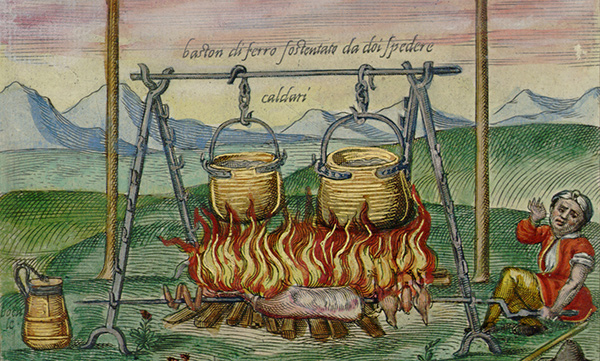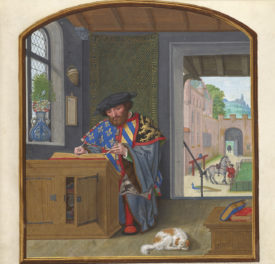
A trip to the culinary section of any bookstore or a quick Google search for a recipe confirms that pictures are an essential part of communicating how to source and prepare food. But how and when did this phenomenon become widespread?
In the late Middle Ages and Renaissance, culinary recipes circulated in both manuscript and print forms, but the inclusion of pictures was the exception, not the rule. In cooking, as in many other artisanal realms, practical experience was the teacher rather than texts or images. But with the advent of printed books, artisans began to record their knowledge, and savvy publishers made it available to the public.
The First Celebrity Chef?
The first cookbook to include extensive explanatory images was Bartolomeo Scappi’s Opera di M. Bartolomeo Scappi, cvoco secreto di Papa Pio V, divisa in sei libri (The work of M. Bartolomeo Scappi, private chef of Pope Pius V, divided into six books), published by Michele Tramezzino in Venice in 1570. Scappi was a celebrity chef who cooked for Roman cardinals before becoming one of the pope’s chefs. His hefty tome includes recipes, menus, and twenty-seven copperplate engravings depicting kitchens, pots and pans, and various devices and special equipment for transporting food.

Cucina Principale in M. Bartolomeo Scappi, Opera (Venice: Michele Tramezzino, 1570), pl. 1. Universitätsbibliothek Göttingen, 8 OEC I, 3660 RARA
A pristine copy of Scappi’s book (digitized here) is included in the Getty Research Institute’s current exhibition The Edible Monument: The Art of Food for Festivals, and the image above is from a rare—possibly one of a kind—hand-colored, lively variant. Captions explain the furnishings and tools, and reinforce the didactic intention of the image, as if to proclaim: Here is what you need to cook like a papal chef!
A kitchen boy turns a spit before a raging fire in the background. Work tables display various foods and implements: a rolling pin, dough, and pasta cutter sit on one, a joint of beef and large knife are set on another, and a third features a group of empty platters waiting to be charged for serving. More like a scientific laboratory than the boisterous, cluttered kitchens rendered in contemporary narrative paintings, such as Vincenzo Campi’s Cucina from the 1580s, Scappi’s vision suggests order, control, and professionalism.

Kitchen, c. 1580, Vincenzo Campi. Oil on canvas, 145 x 220 cm. Pinacoteca di Brera, Milan. Source: Wikimedia Commons
The Art of Drinking Eggs
Another image features a catalogue of brass vessels with iron handles, each with its own moniker. Among this gleaming batterie de cuisine is a special pan for poaching eggs. Eggs, purportedly the papal patron’s favorite food, are featured in many of Scappi’s recipes; there is even a menu for a meal created solely of eggs. The chef’s recipe for soft-boiled eggs, which he calls uova da bere, or drinking eggs, takes the reader through several options for preparing the perfect soft-boiled egg, evidently an elusive quest.

Diversi Vasi in M. Bartolomeo Scappi, Opera (Venice: Michele Tramezzino, 1570), pl. 7. Universitätsbibliothek Göttingen, 8 OEC I, 3660 RARA
One method calls for piercing the egg with a hole “no bigger than a pinhead” before plunging it into boiling water, using the small amount of fluid that emerges as a diagnostic for doneness. Other methods describe almost mystical ways to ascertain the egg’s status, such as holding it in your fist, tapping it with a knife (if it breaks, it is not done), or placing the egg on a table to see if it spins. Trial and error is actually scripted into the recipe. The many duplicate methods convey the author’s vast experience, as well as the potential inadequacy of any single procedure, leading to the conclusion that cooking the perfect egg is a matter of chance rather than skill.
Moveable Feasts
Other images in Scappi’s Opera remind us of the peripatetic nature of early modern courts. The instructions for moveable feasts identify commonplace objects that might have completely vanished from the historical record without such manuals. Scappi’s illustration of the cucina per campagna, or field kitchen, depicts hampers and baskets filled with plates and tablecloths. Another images shows a basket designed to carry dishes, complete with a diagram of how the case looks while empty, with its protective netting unhitched.

Cucina per Campagna in M. Bartolomeo Scappi, Opera (Venice: Michele Tramezzino, 1570), pl. 6.Universitätsbibliothek Göttingen, 8 OEC I, 3660 RARA
In regards to food transportation, the most informative image showcases the food service for a papal conclave. The only double image in in Scappi’s book, it features carefully observed hampers and cases for carrying hot foods from the kitchen, cold foods from the credenza or sideboard, and bottles. The extended written descriptions of the practical arrangements following the death of Pope Paul III in 1549, and the engravings of various furnishings and equipment used during the conclave, reveal the behind-the-scenes activities of the papal kitchen in voyeuristic detail that was unique for its time.

Order and procedures for serving cardinals food and beverages during a conclave (Ordine che si tiene in sede vacante…) Engraving in M. Bartolomeo Scappi, Opera (Venetia: Appresso Michele Tramezzino, 1570), pl. 21, 20.3 x 29.1 cm. The Getty Research Institute, 86-B27679
To return to my first question, why illustrate a cookbook? Scappi’s intimate knowledge of the material world of the papal court and its kitchens was certainly worth illustrating. Moreover, the images were a testament to Scappi’s experience and skill, solidifying his status as a preeminent chef and tapping into the emerging market for illustrated books.
_______
Watch Deborah Krohn speak at the Getty about Scappi’s Opera and his new way of looking at the kitchen.




Comments on this post are now closed.